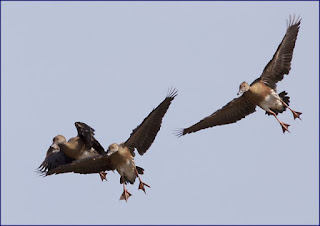In October 2012 112 species were reported to me. This is the highest number compiled in a month since the project started. It is 15 more than September 2012, and 13 more than the number recorded in October 2011. In part this reflects the excellent diversity of waterbirds on a swamp off Plains Road together with seasonal returns. In the Chart below I have used only the last three years in forming the average to reduce the variability due to changes in number of regular contributors.
The most exciting observations have been the influx of Banded Lapwings to the Hoskinstown Plain. By the end of the month up to 37 birds of this species were foraging in the paddock. (A further flock of up to 13 birds was present at the same time on a paddock just outside Bungendore. This is outside the area covered by this project but is mentioned to show the magnitude of this population explosion.
Several species have started breeding as indicated in red in the list below. The number of species reported breeding is somewhat lower than normal possibly reflecting the colder Winter
List of species observed
1 Waterbirds: Musk Duck; Black Swan; Australian Shelduck; Australian Wood Duck; Australian Shoveler; Grey Teal; Pacific Black Duck; Hardhead; Australasian Grebe; Hoary-headed Grebe; Darter; Little Black Cormorant; Little Pied Cormorant; White‑necked Heron; Great Egret: White‑faced Heron; Straw-necked Ibis; Yellow-billed Spoonbill; Dusky Moorhen; EurasianCoot; Black-winged Stilt; Black‑fronted Dotterel; Masked Lapwing; Banded Lapwing; Latham’s Snipe,
2 Birds of Prey: Black-shouldered Kite; Brown Goshawk; Spotted Harrier; Wedge-tailed Eagle; Little Eagle; Nankeen Kestrel; Brown Falcon;
3 Parrots and Relatives: Yellow-tailed Black-cockatoo; Gang‑gang Cockatoo; Galah; Little Corella; Sulphur‑crested Cockatoo; Australian King‑parrot; Crimson Rosella; Eastern Rosella; Red-rumped parrot
4 Kingfishers and other non-songbirds: Stubble Quail; Brown quail; Common Bronzewing; Crested Pigeon; Tawny Frogmouth; Horsfield's Bronze‑Cuckoo; Shining Bronze‑cuckoo; Pallid Cuckoo; Fan‑tailed Cuckoo; Southern Boobook; Laughing Kookaburra; Dollarbird;
5 Honeyeaters: Eastern Spinebill; Yellow-faced Honeyeater; White-eared Honeyeater; Noisy Miner; Red Wattlebird; New Holland Honeyeater; Brown‑headed Honeyeater; White-naped Honeyeater; Noisy Friarbird
6 Flycatchers and similar species: Rufous Whistler; Grey Shrike-thrush; Grey Fantail; Willie Wagtail; Leaden Flycatcher; Magpie-lark; Scarlet Robin; Flame Robin; Hooded Robin; Eastern Yellow Robin; Welcome Swallow; Fairy Martin; Tree Martin
7 Thornbills, Finches and similar species: Superb Fairy-wren; White-browed Scrubwren; Speckled warbler; Weebill; White-throated Gerygone; Striated Thornbill; Yellow‑rumped Thornbill; Buff‑rumped Thornbill; Brown Thornbill; Southern Whiteface; Spotted Pardalote; Striated Pardalote; Silvereye; Double‑barred Finch; Red‑browed Finch; Diamond Firetail; House Sparrow; European Goldfinch
8 Other, smaller birds: White-throated Treecreeper; Black-faced Cuckoo-shrike; Olive‑backed Oriole; Masked Woodswallow; White‑browed Woodswallow; Dusky Woodswallow; Skylark; Golden-headed Cisticola; Australian Reed-warbler; Brown Songlark; Common Blackbird; Common Starling; Mistletoebird; Australasian Pipit;
9 Other, larger birds: Satin Bowerbird; Grey Butcherbird; Australian Magpie; Pied Currawong; Grey Currawong; Australian Raven; Little Raven; White-winged Chough




















